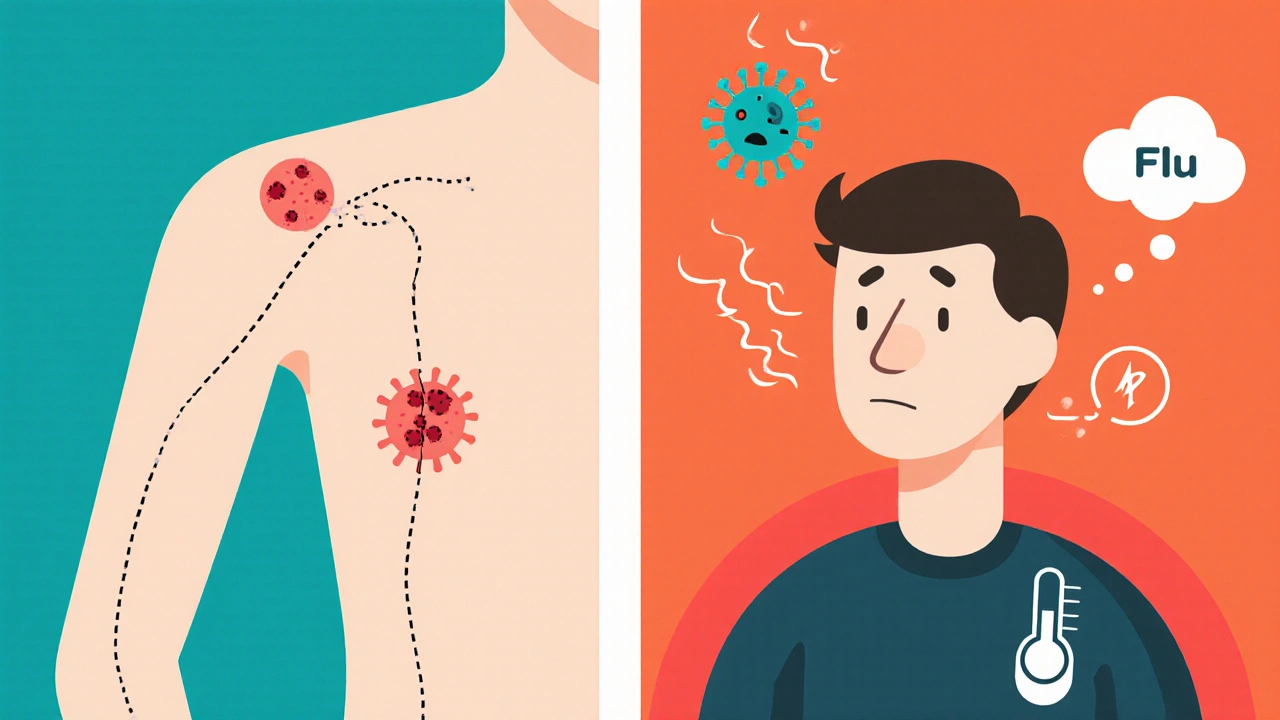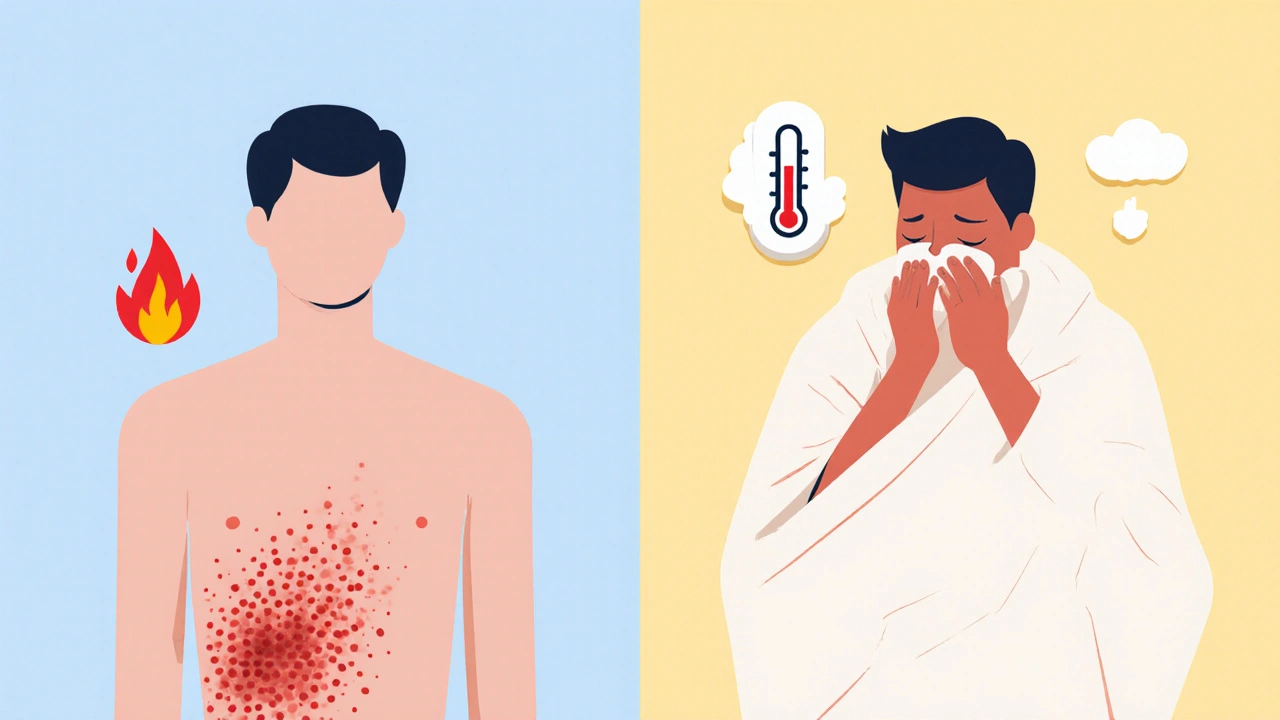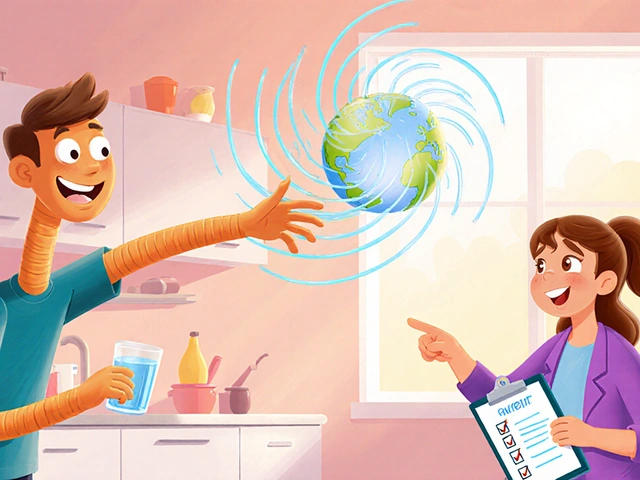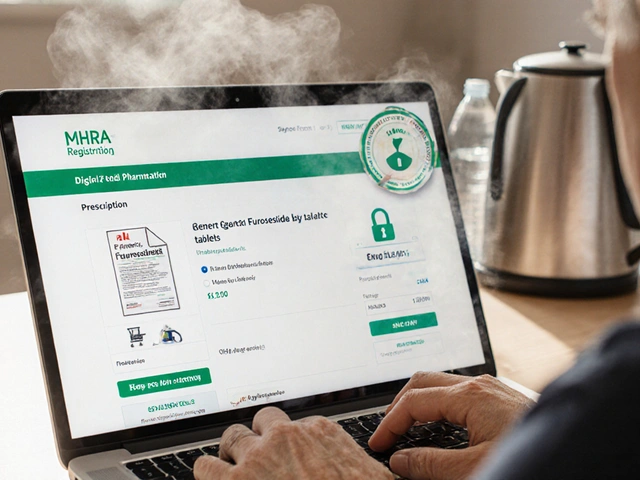Shingles vs Flu Symptom Checker
Symptom Assessment
Select all symptoms you're experiencing. This tool helps identify whether your symptoms are more consistent with shingles or influenza.
Your Symptom Analysis
Ever felt a burning rash and wondered if it’s just a bad flu? Or brushed off a fever thinking it’s only the flu, only to develop a painful rash later? Those two illnesses can look similar at first, but they’re caused by different viruses, have distinct warning signs, and need separate care. Below we break down everything you need to know so you can spot the differences, protect yourself, and get the right treatment fast.
What Is Shingles?
Shingles is a reactivation of the varicella‑zoster virus (VZV), the same virus that causes chickenpox. After a childhood bout of chickenpox, VZV lies dormant in nerve tissue. Years later, often when the immune system weakens, the virus can flare up as shingles, producing a painful, blistering rash that follows a nerve pathway.
Typical shingles symptoms include a burning or tingling sensation on one side of the body, followed by a red rash that turns into fluid‑filled blisters. The rash usually appears on the torso or face, but it can affect any area supplied by a single nerve. Most people recover within a few weeks, but about 10‑15% develop postherpetic neuralgia (PHN), a lingering nerve pain that can last months or even years.
How the Flu Works
Influenza (commonly called the flu) is an infection caused by influenza viruses, primarily types A and B. These viruses target the respiratory tract, leading to sudden fever, chills, muscle aches, cough, and fatigue. The flu spreads easily through droplets when an infected person coughs, sneezes, or talks.
Flu symptoms usually appear 1‑4 days after exposure and last about a week. While many recover without complications, the flu can be dangerous for the very young, elderly, pregnant women, and anyone with weakened immunity. Complications can include pneumonia, sinus infections, and exacerbation of chronic conditions such as asthma or heart disease.
Side‑by‑Side Symptom Comparison
| Aspect | Shingles | Flu |
|---|---|---|
| Primary cause | Varicella‑zoster virus (reactivation) | Influenza A or B viruses |
| Typical onset | Burning/tingling → rash over 1‑3 days | Sudden fever, chills, body aches |
| Rash | Unilateral, blistering, follows nerve line | Rare, usually absent |
| Fever | Low‑grade or none | High (often >38.5 °C) |
| Contagious period | Not contagious once rash appears | From 1 day before symptoms to about 5‑7 days after |
| Common complications | Postherpetic neuralgia, eye damage (if facial) | Pneumonia, bronchitis, worsening of chronic illnesses |

Who’s Most at Risk?
Both illnesses target the immune system, but the risk profiles differ.
- Shingles risk factors: Age over 50, weakened immunity (HIV, cancer treatment, organ transplant), stress, and a history of chickenpox.
- Flu risk factors: Children under 5, adults over 65, pregnant people, chronic heart or lung disease, and anyone without an annual flu shot.
People with overlapping risk factors-say, a 68‑year‑old with diabetes-should be especially vigilant because they could contract either illness and suffer severe outcomes.
Prevention: Vaccines and Lifestyle Choices
The best defense against both illnesses is vaccination, coupled with healthy habits.
- Shingles vaccine: Shingrix, a two‑dose recombinant vaccine, is >90% effective at preventing shingles and PHN in adults 50+. The CDC recommends it even for those who had the older Zostavax.
- Flu vaccine: Updated each year to match circulating strains. It reduces the risk of severe flu by about 40‑60% and cuts hospitalizations dramatically.
- Hand hygiene and masks: Simple hand‑washing, using alcohol rub, and wearing masks in crowded indoor settings lower transmission of respiratory viruses, including flu.
- Immune support: Adequate sleep, balanced nutrition, regular exercise, and managing stress keep the immune system ready to fight off reactivations.
When to See a Doctor: Red Flags
Most mild cases can be managed at home, but certain signs demand prompt medical attention.
- Rash that spreads rapidly, involves the eyes, or is accompanied by severe pain.
- Fever lasting more than 3 days, especially with shortness of breath or chest pain.
- Signs of bacterial infection (pus, increasing redness) on a shingles rash.
- Any flu‑like symptoms in a high‑risk individual (elderly, pregnant, chronic illness) that worsen after 48 hours.
Early antiviral therapy-like acyclovir, valacyclovir, or famciclovir for shingles-must start within 72 hours of rash onset to be most effective. Likewise, antiviral drugs such as oseltamivir (Tamiflu) work best when started within 48 hours of flu symptoms.
Managing Both Illnesses: Treatment Options
While shingles and flu target different parts of the body, there are common strategies for comfort and recovery.
- Pain relief for shingles: Over‑the‑counter NSAIDs (ibuprofen) for mild pain, prescription gabapentin or pregabalin for nerve pain, and topical lidocaine patches.
- Flu symptom relief: Acetaminophen for fever, plenty of fluids, and rest. Antiviral tablets, when prescribed, can shorten illness duration.
- Skin care for shingles rash: Keep lesions clean, use cool compresses, and avoid scratching to prevent secondary bacterial infection.
- Hydration and nutrition: Both conditions increase metabolic demand; sipping electrolytes and eating easy‑to‑digest foods helps the body heal faster.
After the acute phase, monitor for lingering issues. Postherpetic neuralgia may need a longer course of nerve‑pain medication, while flu complications like pneumonia require antibiotics if a bacterial infection is confirmed.
Frequently Asked Questions
Can you get the flu and shingles at the same time?
Yes, it’s possible, though uncommon. Since shingles is a reactivation of a dormant virus and flu is a new respiratory infection, having one doesn’t prevent the other. If symptoms overlap, see a doctor promptly for dual treatment.
How long does a shingles outbreak last?
Typically 2‑4 weeks from the first tingling sensation to full healing of the rash. Pain may linger longer if postherpetic neuralgia develops.
Is the flu vaccine safe for people with shingles?
Yes. The flu shot is an inactivated vaccine and does not interfere with shingles or its vaccine. Getting both shots in the same season is recommended for those over 50.
What should I do if my shingles rash appears on my face?
Facial shingles (herpes zoster ophthalmicus) can affect the eye and cause vision loss. Seek urgent ophthalmology care, start antiviral therapy immediately, and avoid touching the eye.
Can over‑the‑counter painkillers prevent postherpetic neuralgia?
Painkillers alone don’t stop PHN, but early aggressive pain control-often with prescription nerve‑pain agents-can reduce its severity. Discuss options with your doctor as soon as the rash appears.
Understanding the differences between shingles and the flu helps you act quickly, keep complications at bay, and make informed choices about vaccination and treatment. Stay alert to the signs, protect your immune system, and don’t hesitate to reach out to a healthcare professional when in doubt.






8 Comments
Antivirals work best when started within 48 hours of flu symptoms and 72 hours of a shingles rash; any later and the benefit drops sharply.
I cant believe people still ignore that!! It’s a total disaster when you wait too long, the pain just gets worse and the virus spreads faster. Get the meds early or suffer for weeks.
Everyone’s raving about the shingles shot, but why trust big pharma when natural immunity could do the job? Some folks never get it, yet they survive just fine without a needle.
Life is a series of shadows and light; the virus that hides in you and the one that explodes from the air are both teachers. One whispers from the nerves, the other shouts from the lungs. To ignore either is to miss the lesson of balance.
Hey, love the poetic vibe! While it’s true that every ailment has something to teach us, the data still shows the shingles vaccine cuts the risk by over 90 %. That’s not just philosophy, it’s hard science.
Sounds solid 😊
We’re all navigating health choices together, and it’s great to see supportive voices. The flu shot and shingles vaccine each protect different parts of the body, so taking both builds a stronger shield. If you’re uncertain, chat with a clinician who can personalize advice. Remember, community health improves when each person stays informed and proactive. Stay safe, stay kind.
What a fantastic thread! I’m thrilled to see everyone diving deep into the nuances of these illnesses. First, let’s acknowledge that both the flu and shingles can knock anyone down, regardless of age or fitness. Second, the timing of treatment is absolutely critical – antivirals lose their edge the moment the window closes. Third, vaccination isn’t just personal protection; it’s a public health duty that keeps outbreaks at bay. Fourth, the side‑effects of the shingles vaccine are minimal compared to the lingering agony of post‑herpetic neuralgia. Fifth, flu shots are reformulated each year, so staying current is a simple habit with huge payoff. Sixth, maintaining a healthy lifestyle – sleep, nutrition, exercise – fuels the immune system to keep reactivations at bay. Seventh, if you notice a rash that follows a nerve line, don’t wait for it to spread; seek care promptly. Eighth, flu‑like symptoms that linger beyond three days, especially in high‑risk groups, merit a doctor’s visit. Ninth, hand hygiene and mask use remain low‑cost, high‑impact tools in any season. Tenth, remember that the flu can trigger secondary bacterial infections, which may need antibiotics. Eleventh, if you have both conditions simultaneously, dual antiviral therapy can be coordinated safely. Twelfth, staying informed about symptom differences helps you act faster and reduces complications. Thirteenth, support one another by sharing reliable resources, not rumors. Fourteenth, celebrate the advances in medicine that give us these vaccines today. And finally, keep the conversation alive – knowledge spreads faster than any virus!